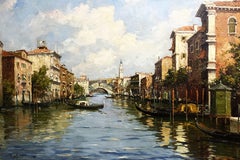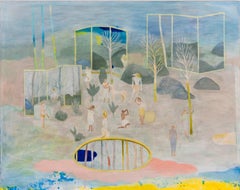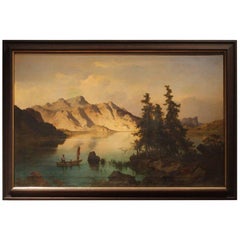Giovanni Vianello Art
to
1
Overall Width
to
Overall Height
to
1
1
1
1
1
1
1
1
1
1
1
10,025
2,756
1,379
1,375
1
Artist: Giovanni Vianello
Padua Venice.
By Giovanni Vianello
Located in Naples, Florida
Padua Venice.
Category
20th Century Giovanni Vianello Art
Materials
Oil
Related Items
Signal distortion #2 Hélène Duclos 21st Century painting landscape cream art
By Hélène Duclos
Located in Paris, FR
This painting is part of the current exhibition entitled "The fantastic story of the liquid mountain" at Claire Corcia Gallery in Paris.
The liquid mountain is populated by living b...
Category
2010s Contemporary Giovanni Vianello Art
Materials
Canvas, Oil
$4,668
H 28.75 in W 36.23 in D 1.97 in
J. Brunner 1869 Oil on Canvas Austrian Landscape with Lake and Mountain Painting
Located in Firenze, IT
This very fine quality 19th century oil on canvas in dark brown wood frame with gold leaves details throughout is signed by Joseph Brunner (Vienna 1826-...
Category
19th Century Romantic Giovanni Vianello Art
Materials
Canvas, Wood, Oil
Joseph BrunnerJ. Brunner 1869 Oil on Canvas Austrian Landscape with Lake and Mountain Painting, 1869
$8,859
H 30.32 in W 43.31 in D 1.97 in
Italian Impressionist Oil on Board Marine Landscape Painting Naples Bay View
By Francesco Coppola Castaldo
Located in Firenze, IT
Everyday fishermen life is captured in this wonderful Italian impressionist late 19th century oil painting on thin board titled fishermen ashore. We love the neutral and natural colo...
Category
Late 19th Century Impressionist Giovanni Vianello Art
Materials
Oil, Board
$4,190
H 20.08 in W 28.75 in D 1.19 in
Venice Landscape Italian Oil on Canvas Painting in Gilt Wood Frame, Belle Epoque
Located in Firenze, IT
This delightful turn of the century (early 20th century) oil on canvas painting represents an Italian landscape with one of the most famous squares in the world: Piazza San Marco in ...
Category
Early 20th Century Impressionist Giovanni Vianello Art
Materials
Canvas, Oil
Venice Landscape Italian Oil on Canvas Painting in Gilt Wood Frame, Belle Epoque, Early 20th Century
$8,529 Sale Price
25% Off
H 51.19 in W 33.47 in D 1.19 in
View of St. John’s Cathedral, Antigua
Located in New York, NY
Provenance:
Robert Hollberton, Antigua, ca. 1841
Private Collection, New York
The present painting depicts Old St. John’s Cathedral on the island of Antigua. The church was erected in the 1720s on the designs of the architect Robert Cullen. It measured 130 feet by 50 feet with north and south porches 23 x 20 ½ feet. The tower, 50 feet high with its cupola, was added in 1789. The church was elevated to the status of a cathedral, but disaster struck in the form of an earthquake that destroyed the building on 8 February 1843. A memorandum of that date relates the event:
“On Wednesday, 8th February, 1843, this island was visited by a most terrific and destructive earthquake. At twenty minutes before eleven o’clock in the forenoon, while the bell was ringing for prayers, and the venerable Robert Holberton was in the vestry-room, awaiting the arrival of persons to have their marriage solemnized, before the commencement of the morning service, the whole edifice, from one end to the other, was suddenly and violently agitated. Every one within the church, after the first shock, was compelled to escape for his life. The tower was rent from the top to the bottom; the north dial of the clock precipitated to the ground with a dreadful crash; the east parapet wall of the tower thrown upon the roof of the church; almost the whole of the north-west wall by the north gallery fell out in a mass; the north-east wall was protruded beyond the perpendicular; the altar-piece, the public monument erected to the memory of lord Lavington, and the private monuments, hearing the names of Kelsick, Warner, Otley, and Atkinson, fell down piecemeal inside; a large portion of the top of the east wall fell, and the whole of the south-east wall was precipitated into the churchyard, carrying along with it two of the cast-iron windows, while the other six remained projecting from the walls in which they had been originally inserted; a large pile of heavy cut stones and masses of brick fell down at the south and at the north doors; seven of the large frontpipes of the organ were thrown out by the violence of the shock, and many of the metal and wooden pipes within displaced; the massive basin of the font was tossed from the pedestal on which it rested, and pitched upon the pavement beneath uninjured. Thus, within the space of three minutes, this church was reduced to a pile of crumbling ruins; the walls that were left standing being rent in every part, the main roof only remaining sound, being supported by the hard wood pillars.”
The entrance from the southern side into the cathedral, which was erected in 1789, included two imposing statues, one of Saint John the Divine and the other of Saint John the Baptist in flowing robes. It is said that these statues were confiscated by the British Navy from the French ship HMS Temple in Martinique waters in 1756 during the Seven Years’ War and moved to the church. The statues are still in situ and can be seen today, much as they appeared in Bisbee’s painting, but with the new cathedral in the background (Fig. 1).
Little is known of the career of Ezra Bisbee. He was born in Sag Harbor, New York in 1808 and appears to have had a career as a political cartoonist and a printmaker. His handsome Portrait of President Andrew Jackson is dated 1833, and several political lithographs...
Category
19th Century Old Masters Giovanni Vianello Art
Materials
Canvas, Oil
Mid Century Modern Framed Ram Boat Signed Oil Signed Jack Lorimer Gray 1950s 60s
By Jack L. Gray
Located in Keego Harbor, MI
Jack Lorimer Gray, 1927-1981, was born in Halifax, Nova Scotia to Scottish parents. His talents as an artist were spotted by E. Wyly Grier while Gray was still a child. He attended t...
Category
1950s Giovanni Vianello Art
Materials
Oil
Threshold
Located in Gloucester, MA
Peter Lyons’s technique approaches photographic realism, but the precision in his paintings is an attempt to communicate a state of awareness, rather than ...
Category
2010s Contemporary Giovanni Vianello Art
Materials
Canvas, Oil
Everett, Massachusetts
Located in Gloucester, MA
Peter Lyons’s technique approaches photographic realism, but the precision in his paintings is an attempt to communicate a state of awareness, rather than ...
Category
2010s Contemporary Giovanni Vianello Art
Materials
Oil, Panel
Autumn Landscape with Purple
By Zygmund Jankowski
Located in Gloucester, MA
Zygmund Jankowski (1925–2009) painted traditional subjects with exuberant irreverence for traditional rules of color, composition, and perspective. He disparaged imitation and deligh...
Category
1980s Contemporary Giovanni Vianello Art
Materials
Canvas, Oil
Imbriglio and revelation Louis-Paul Ordonneau Contemporary painting abstract art
Located in Paris, FR
Oil paint on canvas
Hand-signed by the artist on the back
Louis-Paul Ordonneau is a French painter born in 1975.
He lives and works in Paris.
In 1999, he set up his studio in tempo...
Category
2010s Abstract Impressionist Giovanni Vianello Art
Materials
Canvas, Oil
$5,866
H 36.23 in W 25.6 in D 1.97 in
The place of the unsaid #3 Hélène Duclos 21st Century painting landscape art
By Hélène Duclos
Located in Paris, FR
This painting is part of the current exhibition entitled "The fantastic story of the liquid mountain" at Claire Corcia Gallery in Paris.
The liquid mountain is populated by living b...
Category
2010s Contemporary Giovanni Vianello Art
Materials
Canvas, Oil
$4,668
H 28.75 in W 36.23 in D 1.97 in
The place of the unsaid #1 Hélène Duclos 21st Century painting Contemporary art
By Hélène Duclos
Located in Paris, FR
This painting is part of the current exhibition entitled "The fantastic story of the liquid mountain" at Claire Corcia Gallery in Paris.
The liquid mountain is populated by living beings with a vegetable heart. They roam freely (it seems to us *) between the earth and the air in search of their roots. They bathe and transform in liquid crystal...
Category
2010s Contemporary Giovanni Vianello Art
Materials
Canvas, Oil
$6,225
H 45.67 in W 35.04 in D 1.97 in
Giovanni Vianello art for sale on 1stDibs.
Find a wide variety of authentic Giovanni Vianello art available for sale on 1stDibs. You can also browse by medium to find art by Giovanni Vianello in oil paint, paint and more. Not every interior allows for large Giovanni Vianello art, so small editions measuring 45 inches across are available. Giovanni Vianello art prices can differ depending upon medium, time period and other attributes. On 1stDibs, the price for these items starts at $18,800 and tops out at $18,800, while the average work can sell for $18,800.


